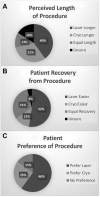Patients' Preference Regarding Laser Photocoagulation or Cryoretinopexy for the Treatment of Retinal Pathology
- PMID: 37007728
- PMCID: PMC9976218
- DOI: 10.1177/24741264211013649
Patients' Preference Regarding Laser Photocoagulation or Cryoretinopexy for the Treatment of Retinal Pathology
Abstract
Purpose: High-risk peripheral retinal pathology can be prophylactically treated with both laser photocoagulation (laser) and cryoretinopexy (cryopexy). We sought to identify a possible preference by patients toward one modality and any underlying association.
Methods: A single-center survey was conducted of patients with peripheral retinal pathology who received both laser and cryopexy at Associated Retinal Consultants (Royal Oak, Michigan). The main outcome measure was the preferred treatment modality.
Results: Patients reported more pain after cryopexy (46%) than laser (11%). Most patients felt it was easier to recover from laser (52%) than cryopexy (13%). Overall, patients preferred laser (60%) to cryopexy (25%), with a minority (15%) having no preference. There was a negative relationship between a patient's likelihood of preferring cryopexy and the number of applications (P = .009).
Conclusions: Most patients preferred laser (60%) to cryopexy. If cryopexy is performed, minimizing the number of freezes may improve the patient's experience and recovery.
Keywords: cryoretinopexy; laser photocoagulation; preference; retinal tear.
© The Author(s) 2021.
Conflict of interest statement
The author(s) declared no potential conflicts of interest with respect to the research, authorship, and/or publication of this article.
Figures





References
-
- Davis MD. Natural history of retinal breaks without detachment. Arch Ophthalmol. 1974;92(3):183–194. doi:10.1001/archopht.1974.01010010191001 - PubMed
-
- Mitry D, Charteris DG, Fleck BW, Campbell H, Singh J. The epidemiology of rhegmatogenous retinal detachment: geographical variation and clinical associations. Br J Ophthalmol. 2010;94(6):678–684. doi:10.1136/bjo.2009.157727 - PubMed
-
- Blindbaek S, Grauslund J. Reply: prophylactic treatment of retinal breaks—a systematic review. Acta Ophthalmol. 2016;94(1):e77–e78. doi:10.1111/aos.12821 - PubMed
-
- Pischel DK, Colyear BH. Clinical results of light coagulation therapy. Am J Ophthalmol. 1960;50(4):590–595. doi:10.1001/archopht.1960.01840010618021 - PubMed
LinkOut - more resources
Full Text Sources

